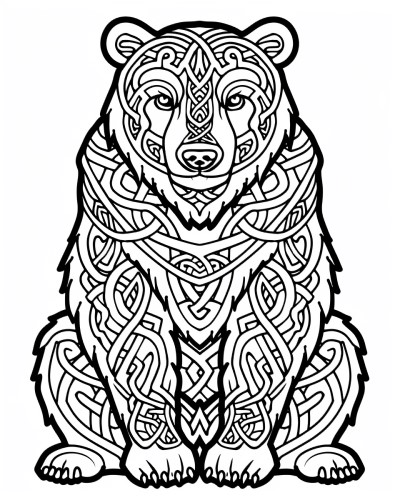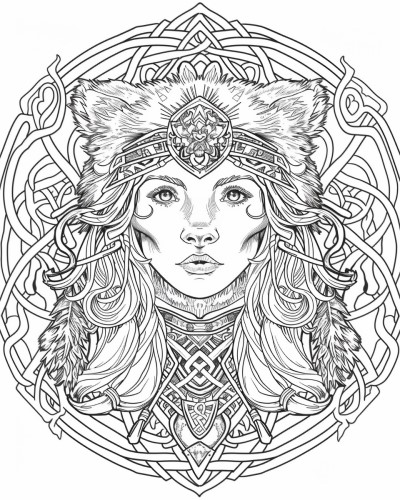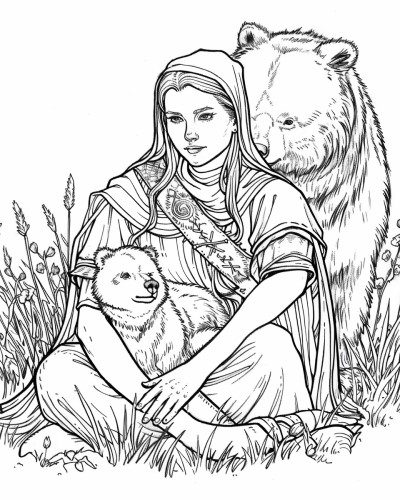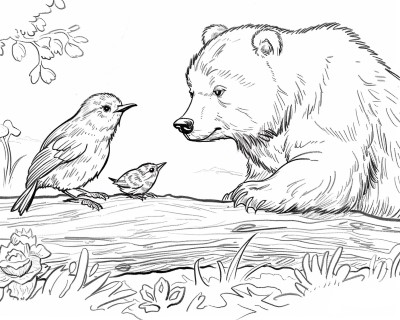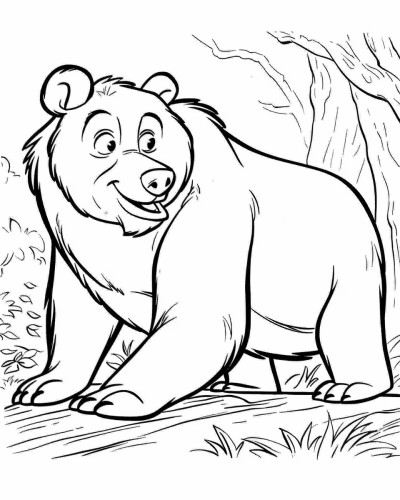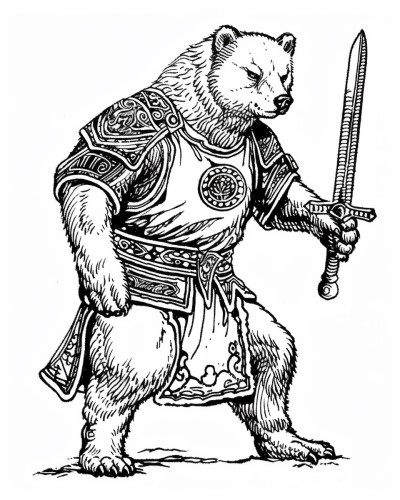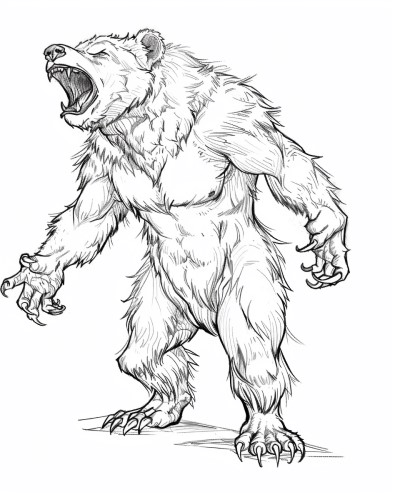Printable Coloring Pages
Bears from Myth and Legend Coloring Pages
Explore the wilds of myth and legend with our Bears from Myth and Legend Coloring Pages. Each page brings to life the powerful bear figures revered in various cultures, from the protective and wise beings of Native American lore to the formidable berserkers of Norse mythology. Perfect for all ages, these coloring pages invite you to connect with the primal strength and majesty of bears as depicted in timeless tales from around the world.
Artio, the Bear Goddess in Celtic Mythology: Artio was a deity associated with bears, depicted as a goddess in bear form or as a human woman with a bear. She represented the cycle of life and death, transformation, and nature's bounty.
Artio is a deity from the Gallo-Roman religious tradition, worshipped particularly in what is now Switzerland. Artifacts depicting Artio in association with a bear have been found, indicating her worship and the significance of the bear in Celtic religious practices.
The Bear and the Wren in European Folk Tales: This widespread tale involves a competition among birds to see who can fly the highest, with the bear often participating or causing trouble. It reflects the bear's prominent place in the European imagination.
Among certain Inuit and other indigenous groups in Alaska, Canada, and Greenland, there are stories and beliefs that the aurora borealis (Northern Lights) represents the spirits of the dead, including animals like bears. These spirits are said to be dancing in the sky, and the flickering lights of the aurora are their movements. The connection to bears specifically can be found in some of these stories, where the aurora might represent the spirits of great bears hunted and honored by the people.
It's important to note that interpretations and beliefs about the aurora vary widely among different cultures and communities. While not all specifically mention a bear spirit, many do emphasize the connection between the natural world, the spirits of animals, and the mystical phenomena like the aurora borealis, reflecting a deep reverence for nature and its interconnectedness.
Berserkers in Norse Mythology: Berserkers were fierce warriors associated with the Norse god Odin. They are often described as fighting in a trance-like fury, and some tales suggest they could transform into bears or wear bear skins to imbue themselves with the bear's strength and ferocity.
Björn the Berserker was reputed for his unparalleled fury in battle, transforming with such ferocity that he was believed to embody the bear's spirit, granting him strength and resilience beyond that of ordinary warriors.
Brother Bear from Native American stories - Many Native American tribes have stories of bears that embody strength, wisdom, and are often considered spiritual guides. These stories can be more complex and carry deeper messages.
In various Native American traditions, the bear is often regarded as "Brother Bear," a term that reflects the deep respect and kinship these cultures feel towards the bear. This familial title signifies the bear's role as a teacher and guardian spirit, embodying qualities such as strength, courage, and wisdom. "Brother Bear" is seen not just as a wild animal, but as a revered member of the community, whose presence and behavior offer valuable lessons on living in harmony with nature and each other. Through stories and rituals, Native American peoples honor this bond, recognizing the bear as both a physical and spiritual brother, guiding them through life's challenges and connecting them more closely to the natural world.
Jean de l'Ours in French Folklore: This character is a folk hero from the Pyrenees, often depicted as having superhuman strength due to his partial bear ancestry. His adventures usually involve fighting off monsters or performing impossible tasks.
In Inuit mythology, the bear, particularly the polar bear, holds a place of respect and significance. Polar bears are revered for their strength, intelligence, and their ability as hunters, embodying the harshness and majesty of the Arctic.
One of the key figures in Inuit mythology related to bears is Nanook (also spelled Nanuk), the master of bears. Nanook is considered the powerful spirit who determines the success of hunters in finding and hunting bears. Inuit hunters believed in treating the bear with respect; they would perform certain rituals and offer prayers to Nanook to ensure a successful hunt and to show respect for the animal's spirit once it was killed. This respect was crucial, as it was believed that mistreating the bear's spirit could lead to bad luck or failure in future hunts.
The Inuit also believed that polar bears were akin to humans, able to walk on two legs and even able to shed their fur to become human. This transformational ability added a mystical quality to bears, blurring the lines between humans and animals in the spiritual world. This connection reinforced the idea that humans and bears shared a deeper relationship, and that bears, as much as humans, were an integral part of the natural and spiritual world of the Arctic.
Through these beliefs, the Inuit culture encapsulates a profound respect and reverence for the polar bear, reflecting a broader understanding of living in harmony with nature and the beings that inhabit it.
Greek Mythology - Ursa Major:
Ursa Major, often known as the Great Bear, is one of the most recognizable constellations in the night sky, steeped in myth and legend across various cultures. This celestial bear, with its prominent asterism known as the Big Dipper or the Plough, has fascinated humanity for millennia. In Greek mythology, Ursa Major is associated with the myth of Callisto, a nymph transformed into a bear and then placed in the heavens by Zeus. In this vast stellar expanse, the stars that form the bear's outline have ignited the imaginations of storytellers, leading to a rich tapestry of stories that span the globe. Ursa Major's presence in the night sky has been a constant source of guidance, inspiration, and wonder, serving as a celestial marker for the changing seasons and a guide for navigation. The Great Bear remains an enduring symbol of the mysteries and beauty of the universe, a stellar reminder of our shared connection to the cosmos.
Werebear:
The concept of a werebear, a being that can transform from human to bear, taps into ancient and widespread myths that fuse human characteristics with the primal essence of bears. Unlike the more commonly known werewolf, the werebear is less prevalent in folklore but nonetheless appears in various cultures, embodying themes of transformation, power, and the wild.
In Norse and Finnish mythology, for example, the notion of the werebear is linked to warriors known as "berserkers," who were said to don bear skins and embody the bear's ferocity in battle, gaining immense strength and resilience. This transformation wasn't always literal; often, it was more about adopting the bear's spirit or essence.
In other cultures, stories of humans turning into bears -- or vice versa -- highlight a deep respect and reverence for the bear, considered a powerful totem animal and spiritual guide. These myths might speak to the close relationship between humans and nature, emphasizing the thin line between the civilized and the wild, and the inherent power and dignity of the bear.
The werebear myth, in its various incarnations, explores themes of duality, the untamed forces of nature within, and the profound transformations that can occur when the wildness of the natural world intersects with human life.
